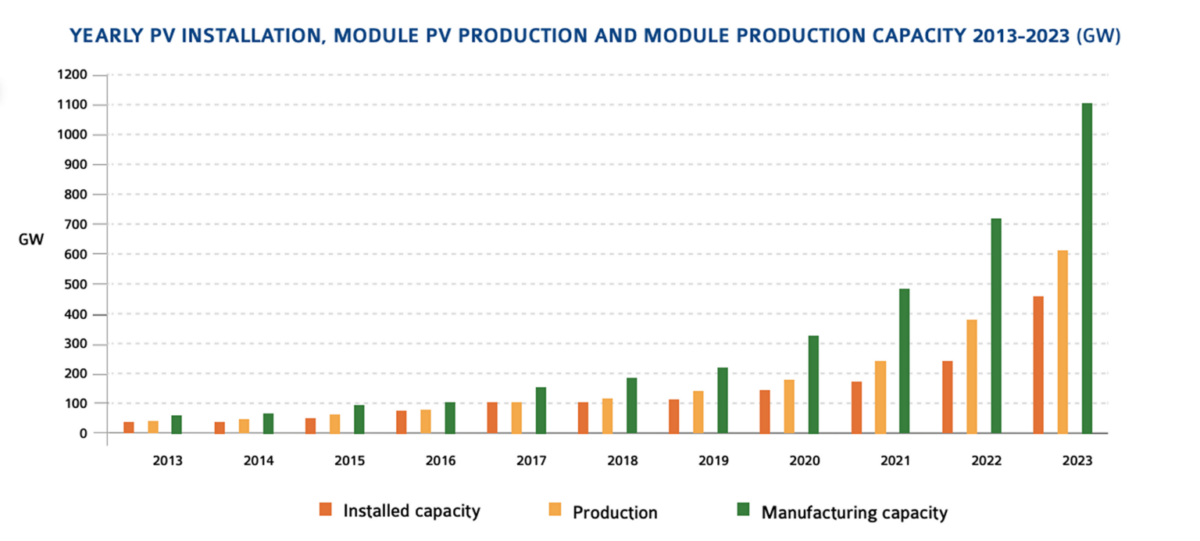From pv magazine Global
The global solar industry is achieving record-breaking growth but faces substantial pressures, particularly in manufacturing, according to the IEA-PVPS.
It said in its latest report, “Trends in PV Applications 2024,” that more than 1.6 TW of PV systems were operational throughout the world by early 2024, producing 2,136 TWh of electricity – equivalent to 8.3% of global electricity demand.
But despite a record year for solar in 2023, which saw 456 GW of new installations, solar development in many countries is suffering from setbacks and delays. The exception is China, which is now concentrating solar development “at a never-seen level” by growing its domestic market to absorb its own industry’s overcapacity, said IEA-PVPS.
It explained that other countries have been unable to match China’s acceleration, resulting in significant overcapacity in the PV manufacturing industry. According to IEA-PVPS figures, China accounted for 92% of global polysilicon production last year, as well as 98% of wafer production, 91.8% of cell production, and 84.6% of module production.
Overcapacity has driven a collapse in the price of PV components, particularly modules, added IEA-PVPS. It said the lowest module price among its reporting countries in 2023 reached around $0.14/W, which is “significantly below anything ever seen before.” It said this is “a direct consequence of large volumes of manufacturing that came online in 2023, well above the market’s capacity to absorb.”
IEA-PVPS also noted that low prices have continued into 2024, dipping under $0.10/W. It says this is threatening the viability of the entire PV manufacturing industry and puts projects intended to create local jobs at risk.
“This temporary imbalance between manufacturing supply and demand has put tremendous pressure on the manufacturing industry and will probably lead to consolidation an possible bankruptcies,” said Gaëtan Masson, manager of IEA-PVPS Task 1. “The current (mid-2024) low prices can be considered as unsustainable, however the competitiveness of PV was already guaranteed on mid-2023 prices, and prospects for a fast development in the coming years remain bright in many countries.”
IEA-PVPS said that countries like the United States and India, which were the third- and fourth-largest solar markets in 2023, behind China and the European Union, could have achieved higher installation levels if various administrative, political and local issues, such as weak grids or limited social acceptance, had been resolved.
The number of countries accelerating large-scale deployment of solar systems is increasing. In 2023, 36 countries installed at least 1 GW of solar, with 54 countries now boasting a cumulative capacity in excess of 1 GW.
Elsewhere in the report, IEA-PVPS said that the global solar sector’s contribution to the global economy has significantly accelerated in the last few years, with the sector now responsible for seven million jobs worldwide. The total business value of the PV sector stood at $400 billion in 2023.
The trends report, now in its 29th edition, is part of IEA-PVPS Task 1, which focuses on market and industry analysis.
This content is protected by copyright and may not be reused. If you want to cooperate with us and would like to reuse some of our content, please contact: editors@pv-magazine.com.








By submitting this form you agree to pv magazine using your data for the purposes of publishing your comment.
Your personal data will only be disclosed or otherwise transmitted to third parties for the purposes of spam filtering or if this is necessary for technical maintenance of the website. Any other transfer to third parties will not take place unless this is justified on the basis of applicable data protection regulations or if pv magazine is legally obliged to do so.
You may revoke this consent at any time with effect for the future, in which case your personal data will be deleted immediately. Otherwise, your data will be deleted if pv magazine has processed your request or the purpose of data storage is fulfilled.
Further information on data privacy can be found in our Data Protection Policy.